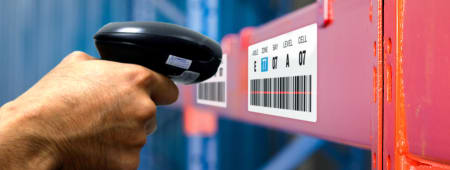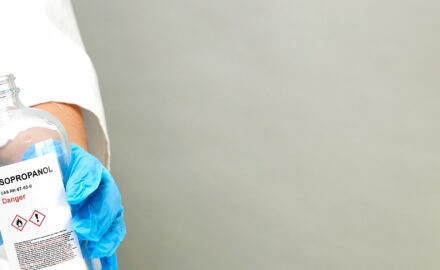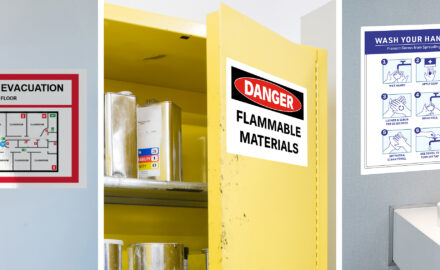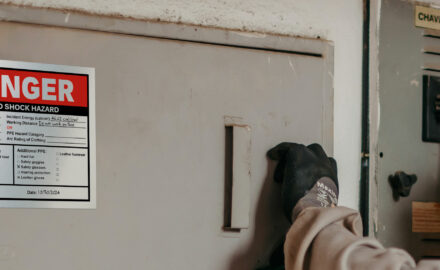
How Barcodes Work
Barcodes are a form of visual coding. Information is encoded in visual patterns that machines can read, gather and store in a central digital database. The visual patterns can be read by machines using either laser or imaging technology.
Laser barcode scanners illuminate the barcode label with a red light that is reflected back to the scanner for decoding. Image scanners capture the image of the barcode using a digital camera (scanning a QR code with your smartphone, for example).
Whether the barcode information is gathered with a laser or camera, the signal is then decoded and sent to a digital database stored on computer software or a device app.
Why You Need Barcode Labels
Using barcode labels to gather and store data is much quicker and more accurate than manually recording data. When a human manually types in a series of numbers and letters there is an inverse relationship between speed and accuracy. The faster they go, the more likely there will be errors.
Scanning a barcode label takes mere seconds and instantly updates your digital database. There is no need for information to be transferred from one file to another or from written forms to computer databases.
For these reasons, asset tags with barcodes are essential to creating the most efficient and cost-effective asset tracking system for your facility. If you’re not convinced you should be tracking assets, you’re missing out on quick asset management wins that help your business reduce time and labor costs.
Types of Barcodes
Barcodes fall into two categories: linear barcodes and 2D barcodes. Linear barcodes (sometimes also called 1D barcodes) represent data by encoding the ones and zeros that computers understand into parallel lines that vary by width and spacing.
Linear barcodes are what most people picture when they hear the term “barcode” and they have been around since the 1950s. 2D barcodes, on the other hand, were not popularized until the 1990s. 2D barcodes encode ones and zeros in two-dimensional symbols and can represent more data per unit area.
Both linear and 2D barcode labels are used across a wide array of industries. Additionally, your business may come into contact with different types of barcode labels at various stages of operation. For example, the types of barcodes listed below span supply chain, manufacturing, packaging, logistics and retail industries.
Common Linear Barcode Labels
ITF (Interleaved 2 of 5)
ITF barcode labels are high-density linear barcodes that pair up every two digits to create a single symbol. High printing tolerance is one of the main benefits of using ITF barcode labels, meaning they’re still scannable even if the printed codes deviate from actual dimensions.
High printing tolerance makes ITF barcode labels ideal for use on corrugated cardboard and other packaging materials. ITF barcode labels are commonly used in the shipping and warehouse industries specifically due to this attribute.
Code 39
Code 39 barcode labels are commonly found in the auto industry and U.S. Department of Defense (DoD). This type of linear barcode originally encoded 39 digits (hence the name) although modern Code 39 barcodes now encode 43 digits.
Code 128
High-density and compact, Code 128 barcode labels are often used in supply chain industries including transportation and logistics. The fact that this type of linear barcode encodes up to 128 digits is important because it supports the 128 characters in the American Standard Code for Information Interchange (ASCII).
ASCII code compatibility means that Code 128 barcode labels can store much more diversified information. This makes them useful barcode labels for shipping containers and other supply chain industries.
Code 93
The compact coding in Code 93 barcodes is a higher density, more secure and approximately 25% shorter than Code 39 barcodes. Code 93 barcode labels are typically used to label electronic components and retail packages. They’re also used by the Canadian Post to provide additional delivery information.
Codabar
Codabar barcode labels are simpler to make than most barcode labels for two reasons. 1) The actual codes can be made using consecutive numbers without the need for a computer. 2) Codabar barcodes can be printed with any impact style printer.
They’re so easy to make that even a simple typewriter can do the trick. Codabar barcode labels are used in logistics and healthcare industries because they are so easy to produce.
UPC (Universal Product Code)
UPC labels feature linear barcodes in two variations of numerical codes. UPC-A barcode labels encode 12 digits and UPC-E encode six digits. UPC barcode labels are used primarily in the retail industry for point-of-sale transactions.
UPC Codes & Check Digits: The last digit (check digit) of a UPC code is used to “check” the accuracy of a scan and is calculated with a formula based on the data in the code. The scanner runs the formula on the data it has scanned and if the answer doesn’t match the check digit, then there is something wrong with either the printed barcode or the scan of the barcode.
EAN (International Article Number)
EAN codes are basically the international version of UPC codes. They look very similar to UPC codes, except they can encode either 13 digits (EAN-13) or eight (EAN-8) for very compact EAN barcode labels.
PDF417
PDF417 barcodes are stacked linear barcodes that hold an incredible amount of information. PDF stands for “Portable Data File” and 417 describes how the information is encoded in the pattern of the barcode. Each pattern is made up groups of 4 bars and spaces, and there are 17 of these groups (or modules).
Just how much information does a PDF417 barcode label hold? Over 1.1 kilobytes of data, which makes them ideal for encoding information such as photos, fingerprints and signatures. PDF417 barcode labels are commonly used in logistics and government.
Common 2D Barcode Labels
QR (Quick Response) Codes
QR codes are perhaps the most well-known type of 2D barcode. QR barcode labels are generally used in marketing and advertising campaigns for retail and entertainment industries because they can hold more information in a smaller space.
In a QR barcode label, data is encoded in squares arranged in both vertical and horizontal patterns, which is what makes them two dimensional. This is also what allows QR barcode labels to hold so much information.
Aside from the amount of information they hold, there are two main benefits to using QR barcode labels. 1) Squares arranged into finder patterns and alignment patterns make it easy for scanners to read even if the barcode label is applied to a round surface, smudged or obscured. 2) They hold numeric, alphanumeric, binary and Kanji data types.
Data Matrix
Data Matrix barcodes are another type of 2D barcode and are very similar to QR codes. The main difference between the two is that Data Matrix barcode labels can be even smaller while still holding a lot of information.
Encoded with only alphanumeric data, Data Matrix barcodes can store up to 2,335 characters. Data Matrix barcode labels are used primarily for labeling small electronic components and are part of standard practices for entities such as U.S. Electronic Industries Alliance (EIA) and DoD.
Aztec
The unique central finder pattern in an Aztec barcode represents a 2D shape reminiscent of Aztec pyramids, which is where this barcode type gets its name. Other key features include no need for a “quiet zone” blank space around the barcode, and very high print tolerance.
Because of these features, Aztec barcodes are some of the smallest and most dependable 2D barcode labels. Aztec barcodes can be reliably scanned even when the print quality is very poor, which makes them ideal for use on transportation industry barcode labels.
Establishing a Database for Your Barcode Labels
When you create a barcode, the information must come from somewhere. In other words, you must decide what information you want to access when the barcode label is scanned. For instance, you might affix barcode labels on your construction company’s machinery or safety equipment in order to quickly access availability as new bids are received.
Each asset could be tagged with a barcode label encoded with the equipment’s status, location, the foreman on the job, contact information and the estimated duration of the project. The simplest way to create a database for this information would be to enter it in an Excel sheet or some other type of spreadsheet.
Continuing with this example, the first row of your spreadsheet might look something like this:
|
ID # |
Status |
Location |
Condition |
Foreman |
Contact Info |
Duration |
The ID number you’ve assigned to each piece of equipment is the information that would be directly represented by the barcode image. When your barcode label is scanned it identifies the equipment, allowing you to instantly access and update the information stored in your database.
Establishing a database for your barcodes is the first step to creating your own barcode labels. Most barcode software and barcode generators allow you to choose between manually entering values and importing them from a spreadsheet.
How to Choose Barcode Label Material Types
The type of material you choose for your barcode labels depends on how and where they’ll be used. Are you creating barcode labels for library books or ID labels for bins and racks in your warehouse? Do you need security tags for company laptops or UPC labels for beverages?
Avery Industrial is an invaluable resource for barcode label sheets and label rolls because you can choose from a wide variety of materials and printing options. Whether you’re printing barcode labels by the sheet or ordering barcode roll labels, Avery Industrial labels offer material options for every application.
Heavy-Duty Barcode Label Materials
Durable metallic labels are ideal for valuable electronics, construction and automotive tools, machinery and other industrial equipment. The most important features to look for are strong permanent adhesive and durable PET facestock that resists tearing, abrasion, water and chemicals.
If you’re printing metallic barcode labels yourself, another key feature to look for is resistance to static buildup. Metallic labels can develop static during printing which can cause an unpleasant shock. Static-resistant printable metallic barcode labels easily solve this issue.
Scratched, damaged and dirty barcode labels can result in incomplete and inaccurate scans. Creating barcode labels with abrasion and tear resistant materials reduces scanning errors from scratched and torn labels. Waterproof or water and chemical-resistant barcode labels can be easily wiped clean to prevent debris from affecting scannability.
Pro Tip: To create barcode labels for marine equipment try BS5609-compliant GHS labels or thermal transfer labels. Both are often used for GHS chemical labeling (which must meet extreme durability, adhesion and print stability standards) and are extremely durable and long-lasting, even resisting UV damage and harsh temperatures.
Removable Durable Barcode Label Materials
What if you need barcode labels strong enough to survive heavy-duty use, but you also need to be able to make regular updates? This is a very common need in lean manufacturing and/or lean warehousing facilities following the 5S/6S practice of constant improvement.
It’s also a common issue in facilities where things like parts bins and warehouse rack locations need to be periodically updated in the natural course of business. Heavy-duty removable labels are needed for both safety and efficiency.
Scraping off old labels every time they need to be changed simply isn’t practical, yet neither is using something so temporary it gets too damaged to be effectively scanned. Heavy-duty barcode labels that stick securely and come off cleanly allow you to quickly and efficiently update labels and avoid unnecessary safety risks like using razors or heat guns during removal.
Waterproof Barcode Label Materials
Waterproof barcode label sheets and barcode roll labels are ideal for creating product labels with UPC barcodes. Using waterproof barcode labels on manufactured goods that contain liquids such as cosmetics and beverages ensures leaks and condensation don’t render barcodes unreadable.
Pro Tip: Large durable waterproof labels are also excellent for creating shipping labels on shipping containers and pallets. No need to protect your shipping labels with layers of packing tape or shiny plastic sheets that can affect scanning.
Light-Duty Barcode Label Materials
Choose light-duty barcode labels for items that require labels tougher than your average paper address label. Office items that frequently change hands, furniture, lab equipment and large printers can all be tagged with light-duty barcode labels.
Pro Tip: When choosing light-duty barcode labels, look for bright white, durable and water and tear-resistant materials. High-contrast barcode labels that you can easily wipe free of dust provide the most consistent scannability.
Formatting Barcode Labels
In order to create custom barcode labels with a barcode generators, you will need to first choose a type of barcode and determine your barcode label size. Next, manually enter values or import them from a spreadsheet. Further customization may include formatting elements such as a company name, logo or other text.
While barcode labels can be created and formatted from scratch, the most efficient way to achieve custom barcode labels is to use specialized software. When using a barcode maker, formatting the size and shape of your barcode labels is key.
Pro Tip: Sign up for (or log in to) your free Avery Design & Print Online (ADPO) account to quickly and easily create and format barcode labels. Choose a preformatted barcode label template to customize your barcode labels without downloading any expensive software.
How to Print Barcode Labels— The Easy Way
Printing barcode labels doesn’t have to be costly or time-intensive. With Avery barcode labels, you can print on blank barcode labels right from your desktop printer. Surface Safe ID Labels, Permatrack™ Asset Tags and other industrial ID labels from Avery come in a variety of shapes, sizes and materials, and there’s no need to invest in a fancy barcode printer.
Once you’ve saved your barcode labels online in your Avery account, you can access them from any device for fast and easy barcode label printing on-demand. Or order barcode labels online through Avery WePrint™, the company’s professional printing service. With no minimum orders and fast turnaround, you can easily scale up your barcode label quantities as needed.
Proper Barcode Label Placement
When tagging company property with barcode labels for tracking assets, where you place the label is largely a matter of common sense and personal preference. You can choose to put a barcode label on the bottom of your industrial jigsaw, but scanning it isn’t going to be very convenient, is it?
However, when it comes to barcode labels on pallets and packaging there are actual rules you must follow in order to meet industry standards. GS1 is a nonprofit organization that provides global standards for business communication.
Below you’ll find some expert tips and the basics of GS1 barcode label standards.
Equipment, Tools and Machinery
Barcode labels on stationary equipment and machinery work best when they are easy to see and reach. If you are placing a barcode label on the side of a stationary machine, ensure 10-12 inches clearance in order to optimally maneuver your barcode scanner.
When tagging tools and other hand-held equipment, consider how the tool is operated and the working end of the tool. For example, a barcode label on a sledgehammer should be placed on the handle above the head and below the grip area to avoid being slammed into debris when it’s in use and to avoid rubbing from extensive handling over time.
Pallet Barcode Labels
- Pallets must be tagged with barcode labels on two adjacent sides.
- Barcode labels should between 15 ¾ and 31 ½ inches (400 – 800 mm) from the bottom and 2 inches (50 mm) from the edge.
- Barcode labels should not cover outer packaging marking.
- Apply barcode labels outside of the pallet if the pallet is homogeneous or the layer pads have been film-wrapped before being grouped into the pallet.
- For in-layer pads that are not film-wrapped, apply barcode labels to a package in the uppermost layer.
- Barcode labels may be landscape format with text on the left and barcodes on the right if there is a shortage of space. Barcodes and text on split labels must be the same size and format as other barcode labels on the pallet.
Outer Package Barcode Labels
Outer package barcode labels should be readable when the package is on a pallet. For this reason, barcode labels should never be placed on the bottom of outer packaging. At a minimum, one side of the package should be tagged with a barcode label unless the package can’t be turned on the pallet, then at least two sides should be tagged with a barcode.
Consumer Package Barcode Labels
- Consumer packages should only have one barcode label.
- Place the barcode label in the lower right corner on the back of the package, never on the bottom if it can be avoided.
- Keep barcode labels between 1/3 of an inch and four inches from the edge of packages.
- Ensure barcode labels are easily readable by scanners: Apply barcode labels on a flat surface avoiding corners, seams and perforations. Keep barcode labels smooth and do not fold them around corners. Avoid allowing cellophane or other film materials to obscure the barcode.
Scanning Barcode Labels
Barcode scanners (or barcode readers) are general input devices similar to a keyboard or a mouse. The scanning device uses a laser or camera to interperet the data encoded in barcode labels and transmits that data to a computer.
To illustrate: a keyboard transmits each letter you type to your computer. It requires input and it requires a connection. If your keyboard and computer are not connected, you can still type words on it, but that information goes nowhere.
When you pass a barcode scanner over your barcode label, the barcode scanner uses the reflected light or image capturing to “read” the barcode. If your scanner and computer are connected, the barcode label information is sent to your computer, the same way manually typing an ID number would.
Pro Tip: If you have a spreadsheet open on your device, scanning a barcode label will automatically locate the encoded information in the spreadsheet.
There are two ways to connect a barcode scanner to a desktop computer or laptop. You can choose a barcode scanner that plugs directly into your computer with a cable, or a Bluetooth enabled barcode scanner that connects wirelessly.
How far away you can be from your computer or device when you are scanning barcode labels with a Bluetooth scanner, depends on the scanner’s Bluetooth capability and varies by model. Class 2 Bluetooth technology generally reaches about 33 feet while Class 1 Bluetooth technology reaches over 300 feet.
Pro Tip: If you’re on a budget, try a barcode scanner app for your phone. RF guns are rugged handheld barcode scanners typically used in warehouses. Many companies are choosing to skip the $1,000 or so investment per RF gun in favor of barcode scanner apps for devices such as smartphones and tablets.
Tracking Assets with Barcode Labels
Bottom line: It is possible to track your company’s assets or set up an inventory management system without an expensive barcode label printer or complicated barcode label software. There are more quality resources to help you get started with barcode labels than ever before.
Some of the most cost-effective resources for creating a barcode system include durable high-performance print-yourself barcode labels and online barcode generator software from Avery Industrial. Barcode scanner apps for your phone and free spreadsheet software, such as Google Sheets, also help make barriers to entry very low.



